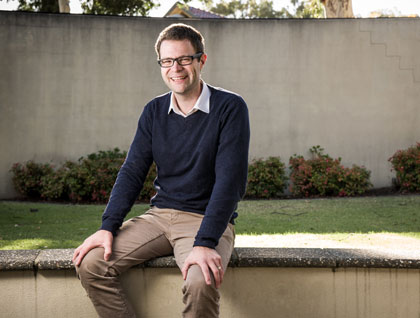Clinicians across Australia are looking forward to the release of the country’s first national guidelines for the diagnosis of autism, to be released in September. Professor Andrew Whitehouse is leading the team developing the guidelines.
The way health professionals diagnose autism differs widely depending on where in Australia they practice.
This postcode lottery can mean delays in diagnosis, misdiagnosis or inequity in access to intervention services for children and their families, adding to the stress parents encounter as they try to navigate a complicated system to ensure their child receives the help they need.
This is set to change in September, however, when a new set of guidelines for the diagnosis of the neurodevelopmental disorder is released at the Asia Pacific Autism Conference in Sydney – ensuring health professionals across the country adhere to world’s best practice.
Professor Andrew Whitehouse, head of the Autism Research Team at The Kids Research Institute Australia, is chairing the project, which was commissioned by the National Disability Insurance Agency and Autism Cooperative Research Centre.
“We have a situation where the process for diagnosing autism is completely different between suburbs, between states, and that doesn’t help anyone,” Professor Whitehouse said.
“It means confusion for families and inequity in terms of access to services. And it provides governments with a huge quandary about how to plan for future service provision if they don’t have a proper idea of the numbers of children being diagnosed.”
Autism is diagnosed based on behaviour, but the assessment of those behaviours currently differs depending on which clinician a family sees.
The most recent statistics show 200,000 Australian families were directly affected by Autism Spectrum Conditions, with 1 in 160 individuals receiving a diagnosis.
Professor Whitehouse said inconsistent diagnosis standards were likely a contributing factor in the huge growth in the number of children being diagnosed, which had doubled every three years since 2006. New data was expected to show 230,000 have autism.
“The National Disability Insurance Scheme offers an exciting opportunity to standardise the process, and ensure a fairer system for families needing help,” Professor Whitehouse said.
He said clinicians across the country agreed the guidelines were long overdue. Autism was the most prominent neurodevelopmental condition that did not yet have consistent diagnostic guidelines.
“At the moment the diagnostic process is not very streamlined,” he said.
“There are often long waiting lists, and it’s often an expensive process, both financially and emotionally, to go through.
“These guidelines hope to streamline this process to ensure every child receives the same diagnostic protocols, and that families can be sure of the diagnostic outcomes.”
The comprehensive guidelines will outline who is qualified to diagnose autism, what assessments they should use, and where children should be observed.
“This is about upskilling the national workforce in the diagnosis of autism, which will give families more confidence going forward,” Dr Whitehouse said.
What’s next?
The next step will be to inform all Australian clinicians about these guidelines, and ensure that health professionals have adequate resources to provide the best practice diagnostic process.
What are autism spectrum conditions?
A group of complex neurobiological disorders that typically last throughout a person’s lifetime. Characterised by varying degrees of impairment in communication and social skills and by repetitive behaviours.
